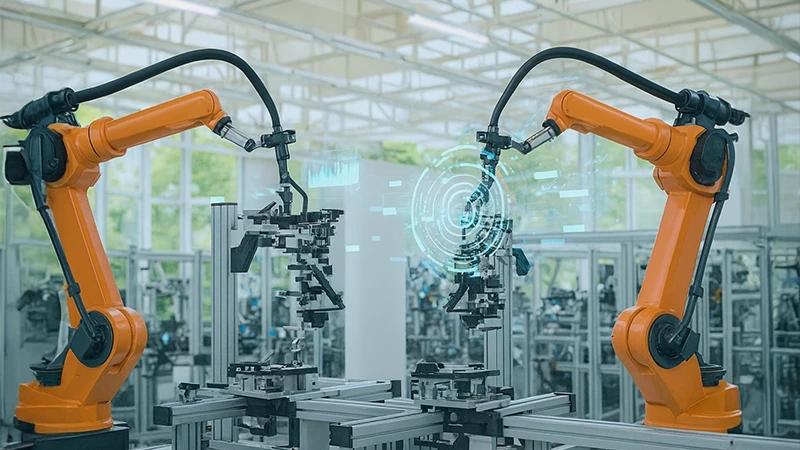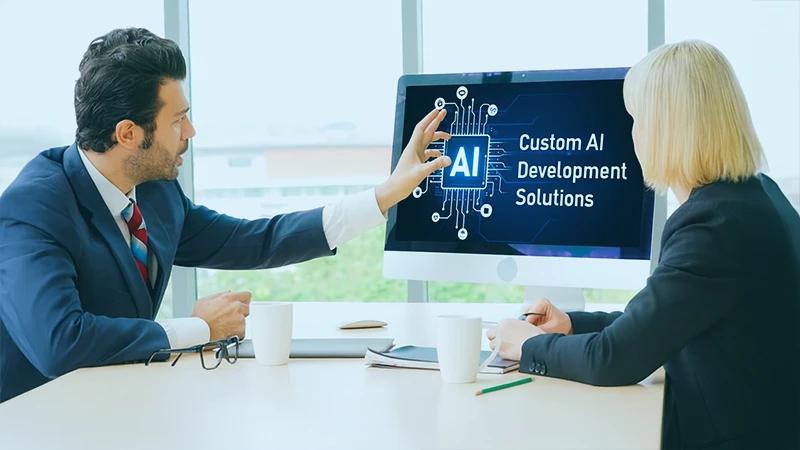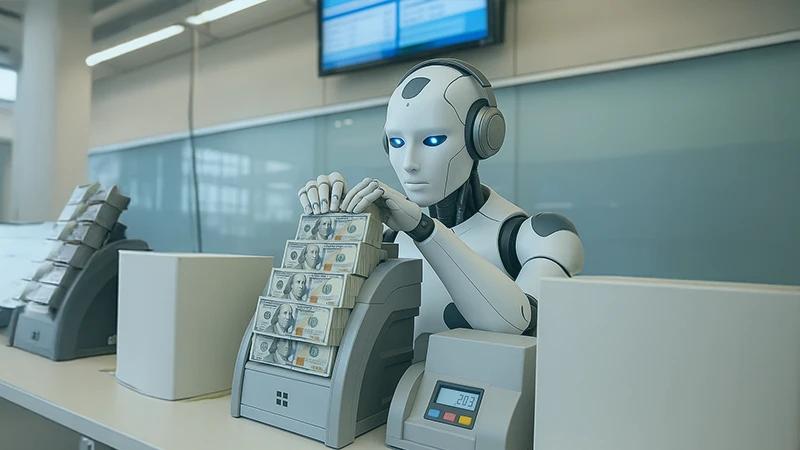Just a few years ago, “digital transformation” was the boardroom buzzword. Today, that conversation has evolved. CEOs are now asking a different question:
"How do we build an organization that thinks, acts, and learns on its own?"
That’s the promise of AI Agent-driven enterprises, organizations where autonomous, intelligent systems don’t just execute tasks but collaborate with humans to achieve business goals. Yet, while 90% of executives say AI is critical to their company’s success, most still operate with legacy AI models, static, siloed, and dependent on human orchestration.
This guide walks you, the CEO, through how to lead your organization into this new era, from vision to execution, using a practical framework that blends strategy, governance, and culture.
Quick takeaway: The next competitive advantage won’t come from who uses AI, but from who builds their business around AI Agents.
Why CEOs Must Lead the AI Agent Transformation
From Automation to Autonomy: The New AI Curve
Traditional automation helps organizations run faster. AI Agents help them run smarter. Automation follows rules. AI Agents follow goals, adapting to context, learning from data, and collaborating across functions.
For example, an RPA bot processes invoices the same way every time. But a Finance AI Agent analyzes past cash flow, forecasts liquidity, and recommends actions to prevent shortfalls.
Gartner predicts that 40% of large enterprises will have deployed AI Agents to manage complex decision-making within the next two years.
“AI Agents aren’t the next phase of automation; they’re the beginning of enterprise autonomy.”
The Competitive Risk of Waiting
Early adopters are already seeing compounding advantages.
- Amazon uses AI Agents in supply chain management to dynamically reroute inventory.
- JPMorgan Chase deploys AI-powered compliance agents to monitor millions of transactions daily.
- Unilever uses marketing AI agents to test and optimize campaigns across global markets in real time.
The result? Faster feedback loops, fewer bottlenecks, and more time for creative strategy.
Bottom line: Inaction is the new risk. The cost of delay isn’t inefficiency; it’s irrelevant.
Understanding the AI Agent-Driven Organization
What Is an AI Agent-Driven Enterprise?
An AI Agent-driven organization is one where autonomous systems, or digital agents, handle core business operations in collaboration with humans. These agents understand goals, interpret data, make decisions, and act independently within defined boundaries.
Think of them as digital employees, ones that never sleep, never guess, and constantly learn.
Examples include:
- Supply Chain AI Agents predicting demand fluctuations
- Finance Agents optimizing working capital
- Customer Success Agents proactively identifying at-risk accounts
Key Characteristics of Agentic Enterprises
- Continuous Learning: Agents improve through feedback loops.
- Collaborative Ecosystem: Humans and agents co-orchestrate outcomes.
- Real-Time Adaptation: Systems respond instantly to market changes.
- Outcome-Oriented Design: Every agent aligns with business KPIs.
When these traits align, the enterprise shifts from reactive management to proactive orchestration.
The Organizational Shifts Required
Transitioning to an agentic model isn’t just about tech; it’s about rethinking leadership and structure.
CEOs must lead shifts in:
- Mindset: From controlling outputs to enabling intelligent autonomy
- Governance: Establishing accountability for AI-driven actions
- Infrastructure: Ensuring data pipelines, APIs, and observability tools are in place
“Technology doesn’t transform organizations; leadership does.”
| Phase | Focus | Key Outcome |
|---|---|---|
| Assess | Evaluate readiness | Identify AI agent opportunities |
| Architect | Design systems & structure | Define AI agent ecosystem |
| Activate | Pilot and integrate | Achieve measurable business impact |
| Align | Enable culture & leadership | Ensure organization-wide adoption |
| Accelerate | Scale with governance | Build long-term sustainability |
Step 1: Assess – Where You Stand Today
Start by mapping your current capabilities:
- How mature is your data infrastructure?
- Are your workflows AI-compatible?
- Do your teams understand AI’s potential?
✅ Checklist: CEO Readiness for Agentic Transformation
- Centralized, high-quality data sources
- AI strategy aligned with business goals
- Cross-functional teams for AI adoption
- Leadership buy-in and literacy programs
- Defined pilot use cases
If you score below 4/5, start with foundational modernization before AI agent deployment.
Step 2: Architect – Design the AI-Agent Ecosystem
Think of this phase as organizational architecture 2.0.
Your goal: identify which business processes can be handled or enhanced by AI Agents.
Example mapping:
- Customer Support → Conversational AI Agents
- Finance → Risk analysis & forecasting agents
- HR → Talent engagement and onboarding agents
Design interoperability: how agents talk to each other and humans.
Define clear boundaries: Agents should act autonomously but within ethical and operational limits.
Tip: Create an “AI Agent Org Chart” to envision each department having digital counterparts working alongside human managers.
Step 3: Activate – Pilot, Test, and Integrate
Begin small. Choose one or two high-impact use cases where AI Agents can prove value fast. For hands-on implementation, our Custom AI Agent Development helps design and deploy agents specific to your workflows.
Example:
A Customer Success AI Agent analyzes CRM data, identifies at-risk customers, and triggers personalized retention campaigns. Within 90 days, it reduces churn by 18% and increases renewal rates.
That single pilot becomes your internal proof of value, fueling executive and cultural buy-in.
“AI Agents don’t replace teams; they remove friction so teams can excel.”
Step 4: Align – Culture, People, and Change Management
No transformation survives without people alignment.
CEOs must drive an AI fluency movement, ensuring every department understands what AI Agents can (and can’t) do.
Steps to align culture:
- Communicate why the shift is happening
- Reassure employees; focus on augmentation, not replacement
- Incentivize AI-driven innovation through recognition programs
“The companies that win with AI are those whose people believe in it.”
Step 5: Accelerate – Scale with Governance and Ethics
Once pilots prove value, scale responsibly.
Establish:
- AI Governance Boards: Oversee transparency, fairness, and compliance
- AgentOps Frameworks: Monitor, retrain, and audit AI Agents
- Ethical Guardrails: Prevent bias, ensure explainability, and track performance
As adoption expands, shift focus from ROI to responsible impact, making sure your AI Agents act in alignment with company values and regulations.
Real-World Use Cases and Success Stories
Manufacturing: Predictive Maintenance Agents
A global manufacturer deployed AI Agents that monitored equipment sensors. Agents predicted failures days in advance, reducing downtime by 30%.
Outcome: $12M annual savings.
Finance: Autonomous Compliance Agents
A leading bank introduced audit agents capable of reviewing transactions in real time.
Result: 40% faster compliance checks and 25% cost reduction.
Retail: Personalized Shopping Agents
E-commerce players use shopping AI agents that adapt recommendations dynamically.
Outcome: 22% higher conversions and improved loyalty scores.
Each AI Agent becomes a living, evolving extension of your business strategy.
Overcoming Challenges and Resistance
Common Roadblocks
- Data fragmentation
- Fear of job loss
- Unclear ROI measurement
- Lack of governance standards
CEO Action Plan
- Start transparent: Explain AI’s purpose early
- Quantify success: Define measurable KPIs
- Upskill talent: Invest in continuous AI learning
Remember, transformation isn’t a sprint. It’s a system shift. Your role isn’t to manage AI, it’s to enable it.
Building a Sustainable AI Agent Governance Model
Establishing Ethical and Legal Oversight
Create a cross-functional AI Governance Board with stakeholders from compliance, technology, and HR. Their role: define policies for explainability, auditability, and ethical decision boundaries.
Monitoring and Performance Management
Define KPIs for each AI Agent:
- Accuracy
- Efficiency gains
- Decision confidence levels
Implement ongoing retraining and observability, ensuring Agents stay aligned with evolving goals.
The Future of Leadership in an Agentic Enterprise
The CEO as Chief Orchestrator
In agentic organizations, CEOs shift from managing operations to orchestrating intelligence. You’re no longer directing every decision; you’re guiding a hybrid workforce of humans and digital agents toward outcomes.
Shifting from Efficiency to Creativity
Once AI Agents handle repetitive decisions, human leaders can focus on:
- Innovation
- Strategy
- New market creation
“In the AI Agent era, leadership isn’t about scale, it’s about symphony.”
Conclusion: Your Next 90 Days to an AI Agent-Driven Organization
Transformation starts with momentum, not mastery. Here’s your 90-day roadmap:
- Next 30 Days: Identify two business areas ripe for AI Agent adoption
- Next 60 Days: Launch a pilot with clear KPIs
- Next 90 Days: Measure impact and build an AI adoption blueprint
Tomorrow’s leaders won’t just use AI; they’ll lead with it.
Ready to explore your organization’s Agentic AI potential? Connect with our AI Experts to design your roadmap today.






